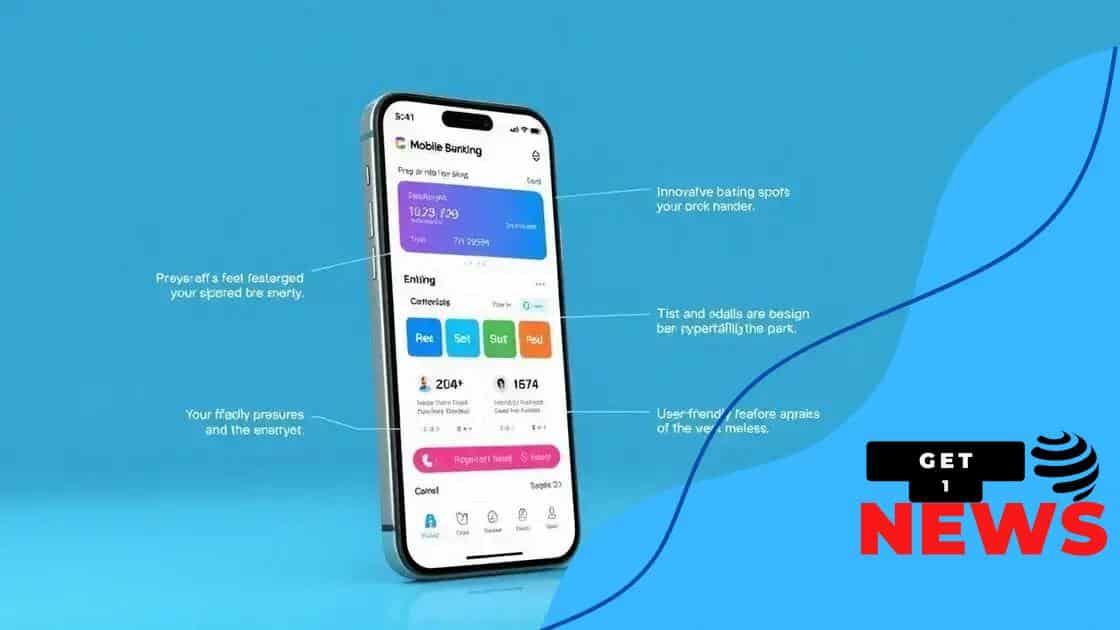Mobile banking innovation in 2025: what you can expect

The future of mobile banking in 2025 includes innovations like enhanced security through biometrics, personalized services using AI, and streamlined digital wallets, all aimed at improving user convenience and safety.
Mobile banking innovation in 2025 promises to reshape the way we interact with our finances. It’s not just about convenience; it’s about revolutionizing your day-to-day banking experience. Ready to see what’s coming next?
Trends shaping mobile banking in 2025
The world of banking is rapidly evolving, and trends shaping mobile banking in 2025 are critical to understand. At the forefront are advancements in technology that will redefine how users interact with their financial institutions. Can you imagine managing all your banking needs from the palm of your hand?
Artificial intelligence (AI) is playing a pivotal role in these changes. By analyzing user behavior, banks can offer personalized experiences and products tailored to individual needs. With these innovations, banking becomes not just easier but also smarter.
Key Trends to Watch
As we look ahead, several key trends are emerging:
- Enhanced Security: With security breaches on the rise, mobile banking apps are implementing cutting-edge cybersecurity measures, including biometric authentication and advanced encryption.
- Seamless User Experience: Future apps will boast intuitive designs, allowing users to complete transactions in fewer steps and with greater ease.
- Integration of Cryptocurrencies: As digital currencies gain popularity, we can expect mobile banking platforms to offer integration features, providing users with greater access.
- Social Media Integration: The intersection of banking and social media will enable peer-to-peer payments directly through platforms like Facebook or Twitter.
Moreover, the rise of contactless payments will contribute to the growth of mobile banking. Users will continue to prefer quick and convenient payment methods, leading to a decline in cash transactions. For instance, tapping a phone against a terminal will become the norm as technology advances.
The adoption of blockchain technology is another significant trend. Mobile banking will leverage this technology for real-time transaction processing and enhanced transparency. Imagine being able to see each step of a transaction instantly, fostering trust and reliability.
As we embrace these upcoming transformations, the key takeaway is that mobile banking in 2025 will focus heavily on enhancing the user experience while ensuring safety and innovation. Consumers will benefit from more options and greater control over their financial activities.
The role of AI in mobile banking
Artificial intelligence plays a crucial role in transforming mobile banking. By analyzing vast amounts of data, AI helps banks provide personalized services to their customers. Imagine receiving tailored financial advice right on your smartphone based on your spending habits and preferences.
Personalization of Services
One of the main benefits of AI in mobile banking is the personalization of services. AI algorithms can analyze user behavior to suggest products that fit individual needs. This means customers will see relevant offers, making banking feel more intuitive and user-friendly.
- Custom Financial Advice: Users can receive tips on budgeting and saving based on their transaction history.
- Smart Chatbots: AI-powered chatbots are available 24/7 to assist customers with inquiries and transactions.
- Automated Alerts: Banks can send alerts for unusual activity, helping users keep their accounts secure.
In addition, AI enhances security measures in mobile banking. Machine learning models can detect fraudulent activities in real-time by identifying patterns that deviate from normal behavior. This proactive approach minimizes risks and provides peace of mind for users, allowing them to bank confidently.
AI also improves operational efficiency for banks. By automating routine tasks, banks can focus on delivering better customer experiences. Tasks like processing transactions and managing customer inquiries become faster and more accurate with AI support. As a result, customers experience quicker service and fewer errors.
Furthermore, AI leads to innovation in product offerings. Banks can leverage AI to create new financial products that meet emerging customer needs. For example, AI can analyze market trends to help develop investment options that appeal to users looking for growth.
As we look toward the future, the integration of AI in mobile banking will continue to grow. Customers can expect a more personalized, secure, and efficient banking experience, driven by the capabilities of artificial intelligence.
Security advancements for mobile transactions

With the rise of mobile banking, security advancements for mobile transactions have become essential. As more people rely on their smartphones for financial activities, ensuring the safety of sensitive information is a top priority.
One significant advancement is the use of biometric authentication. Technologies like fingerprint scanning and facial recognition provide a more secure way for users to log into their banking apps. This not only enhances security but also improves user convenience by eliminating the need for complex passwords.
Encryption Techniques
Another critical aspect of mobile transaction security is advanced encryption techniques. Data encryption protects user information by converting it into a code. Even if a hacker intercepts the data, they will not be able to read it. Banks are investing in state-of-the-art encryption methods to ensure that transactions remain confidential and secure.
- End-to-End Encryption: This method secures data at both the sender’s and receiver’s ends, preventing unauthorized access.
- Encryption at Rest: Data stored on devices is encrypted to protect it from theft, even when the device is lost.
- Real-Time Monitoring: Banks use AI algorithms to monitor transactions for any suspicious activity, alerting users immediately if something seems off.
Furthermore, the implementation of two-factor authentication (2FA) adds an extra layer of security. Users must verify their identity through a second method, such as receiving a code via SMS, before completing a transaction. This greatly reduces the risk of unauthorized access to accounts.
Some banks are also introducing tokenization techniques. This process replaces sensitive information with randomly generated tokens that can only be used for specific transactions. If a token is intercepted, it does not provide any usable data to the hacker.
As mobile banking continues to evolve, we can expect ongoing innovations in the security of mobile transactions. These advancements not only protect users but also build trust in mobile banking solutions by ensuring that financial data remains safe.
Customer experience improvements in mobile apps
Enhancing customer experience improvements in mobile apps is vital for banks seeking to retain and attract users. Mobile apps have become the primary way people manage their finances, so creating a seamless experience is essential.
One major improvement is the focus on user interface (UI) design. Banks are investing in clean, intuitive layouts that make navigation easier. Users can quickly find what they need, whether paying bills or checking balances, which significantly boosts satisfaction.
Personalized Insights
Another key enhancement is the integration of personalized insights. With the help of AI, these apps can analyze user transactions to provide tailored financial tips. For example, users might receive suggestions on budgeting based on their spending patterns, making the experience more relevant and helpful.
- Custom Notifications: Apps can send personalized alerts for upcoming bills or unusual account activities.
- Goal Setting: Users can set financial goals, and apps will track their progress, providing encouragement along the way.
- Interactive Features: Engaging tools, like spending trackers and savings calculators, empower users to take control of their finances.
By including educational resources within the app, banks can further enhance the user experience. Tutorials and FAQs help users understand features and improve their financial literacy. This creates a stronger relationship between customers and their bank, as users feel more informed and confident.
Moreover, the usage of chatbots is transforming customer service for mobile banking. These AI-driven tools are available 24/7, providing instant answers to common questions. This not only reduces wait times for human support but also helps resolve issues quickly.
Responsive design is also crucial. No matter the device used, mobile banking apps should work flawlessly. This means ensuring that users can easily access their accounts whether on a smartphone, tablet, or other devices. Continuous testing and updates are necessary to maintain high performance, adapting to new technology as it emerges.
As banks continue to focus on enhancing the customer experience, the expectation is that mobile apps will become even more user-friendly and innovative. The investments made today will lead to satisfied customers who are more likely to remain loyal.
The future of digital wallets and payment methods
The future of digital wallets and payment methods is bright, with continuous advancements shaping how we handle our finances. Digital wallets are becoming more prevalent as consumers seek convenience and speed in transactions. With just a tap or swipe on their devices, users can manage payments effortlessly.
A major trend is the integration of multiple payment methods within a single digital wallet. This allows users to store credit cards, debit cards, and even cryptocurrencies all in one place. For example, a user can pay with Bitcoin at a café that accepts digital currency, making transactions seamless and efficient.
Security Enhancements
As digital wallets become more popular, security measures are evolving as well. Biometric authentication, such as fingerprint or facial recognition, adds a layer of protection. This means that even if a device is lost or stolen, unauthorized users cannot access sensitive payment information.
- Tokenization: This process replaces sensitive card information with a unique token, significantly reducing the risk of fraud.
- Encrypted Transactions: Using advanced encryption, transaction data is protected, ensuring that only the intended recipient can access it.
- Real-Time Fraud Detection: AI algorithms can analyze transaction patterns and flag suspicious activity instantly, providing users peace of mind.
In addition to security, the user experience of digital wallets is improving. Intuitive interfaces make it easy for anyone to navigate and use these apps. Automatic updates help users stay on top of new features and security practices without extra effort.
Moreover, the rise of contactless payments is pushing the adoption of digital wallets. Retailers are increasingly installing contactless terminals, making it easier for customers to check out swiftly. The combination of speed and safety appeals to many consumers who desire quick and convenient methods to pay.
As mobile technology continues to evolve, so too will the features of digital wallets. We can anticipate ongoing innovations, like loyalty programs integrated within the wallet, allowing users to earn rewards while they shop. These enhancements will make digital wallets even more valuable tools for managing finances effectively.
FAQ – Frequently Asked Questions about Mobile Banking Innovations
What are the main benefits of using digital wallets?
Digital wallets offer convenience by consolidating multiple payment methods into one app, allowing quick and easy transactions.
How does biometric authentication improve security in mobile banking?
Biometric authentication, like fingerprint and facial recognition, ensures that only the authorized user can access the banking app, significantly reducing the risk of fraud.
What innovations are expected in the future of mobile banking?
Future innovations may include enhanced personalization through AI, better integration of cryptocurrencies, and more advanced security measures.
How can I ensure the safety of my mobile banking transactions?
Always use secure passwords, enable two-factor authentication, and keep your mobile banking app updated to protect against security threats.





